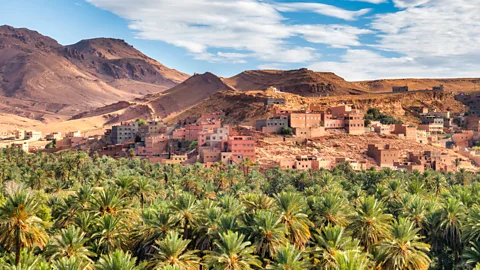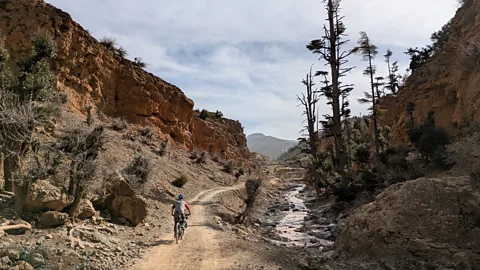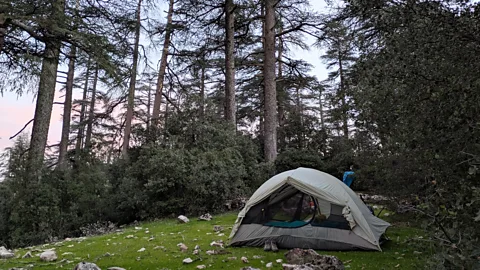Morocco's new cross-country cycling route
 Alamy
AlamyWinding from southern deserts into snowcapped mountains towards northern beaches, the Route of Caravans offers adventurous travellers a stunning glimpse of the nation few tourists see.
"No route, no route!" said a smiling man wearing a long white robe and holding a stout shepherd's staff, his donkey in tow. He pointed over his shoulder, down the U-shaped canyon I had planned to follow to the nearest road, which was still several kilometres away. He then motioned towards the ground, indicating that the rough terrain my travel companion and I were pushing our bicycles over continued long into the canyon.
"That's okay," I said to him in French, shrugging in the direction we'd come from. "There's no route back that way, either." It wasn't precisely true. While the canyon trail we'd been traversing in Morocco's soaring High Atlas mountains wasn't exactly manicured, it was nevertheless part of a brand-new bikepacking route.
We had just set out on the 837km Route of Caravans: Morocco Traverse (North), the second leg of a recently completed two-tier cycling trail traversing the length of Morocco from the town of Tiznit on the country's south-western coast to Tangier in the north. Since a digital map of the route's northern leg debuted on the adventure-cycling website Bikepacking in autumn 2024, it has lured bikepackers (off-road cyclists who carry overnight gear) to wind, slalom and climb their way from the town of Imilchil in the High Atlas Mountains past rolling hills and alpine es to the Mediterranean port city, where they can catch a ferry across the Strait of Gibraltar to Spain.
 Getty Images
Getty ImagesTracing its arc from southern desert to northern beaches, the trail's two legs make use of ancient caravan roads trod by camels' hooves and shepherd paths used by the country's Indigenous Amazigh (long referred to as "Berber" by outsiders) communities who have called Morocco home for some 20,000 years. The route is the result of a long-held dream of a handful of adventurous international cyclists keen to forge a path through some of Morocco's least-visited regions.
Set Out
Set Out is a BBC Travel series that celebrates slow, self-propelled travel and invites readers to get outside and reconnect with the world in a safe and sustainable way.
To me, it felt like slipping through the country's backdoor and, occasionally, a bit like time travel. Following narrow paths through pastures where shepherds graze flocks on rain-fed grass, I got a firsthand glimpse of the seasonally nomadic lifestyle that still thrives in the mountains. In remote canyons, I met Amazigh women who piled their donkeys high with edible herbs and wildflowers foraged in meadows far from their mud-brick homes.
The Route of Caravans is one of many long-distance bikepacking routes sprouting up around the world in places like the Peruvian Andes, North America's Continental Divide and the Scottish Highlands where intrepid two-wheeled travellers can immerse themselves in stunning natural settings and remote communities. The challenges these routes present – such as terrain so rugged you may occasionally "hike-a-bike" instead of pedalling it – are all part of the appeal.
The new route also had a personal draw for me. Having travelled to Morocco decades earlier and following the classic tourist's itinerary between cities like Fez, Marrakech and Essaouira, I was haunted by glimpses of the more remote places I ed between such sites, and curious about those who lived there. Riding the Route of Caravans would be a return, of sorts – one focussed less on sites themselves than on the places in between.
 Jen Rose Smith
Jen Rose SmithAfter checking my steel mountain bike as baggage on the flight and strapping it with bags to carry my clothes, camping gear and equipment, I set off from the bus station at Beni Mellal, a 135km ride from the route's starting point in Imilchil, beginning a slow climb into the still-snowy summits of the High Atlas mountains. Over the next two weeks, the Route of Caravans would carry me across three mountain ranges, into ancient cities, through Amazigh villages and towards Tangier, where two seas and continents meet.
"[The route is] shockingly diverse," said Evan Christenson, a cyclist from San Diego, California, who scouted and designed the route for Bikepacking. "You go from the High Atlas, which is just exposed raw granite, and into the green and rolling pastures of the Rif Mountains… There are different cultures you go through, too."
More like this:
• Scotland's epic 210-mile bikepacking adventure
• A new 5,500km bike trail connecting one of Europe's most remote regions
Cycling between the villages of the High Atlas mountains, I saw the anthropomorphic yaz symbol (representing freedom and independence for the Amazigh) scrawled on the houses and shepherd huts. And while I'd heard intermingled French and Arabic in the streets of Marrakech, many of the people we met in the mountains spoke dialects of the Amazigh language Tamazight.
"Azul," I said, on the second day on the route, when I ed a handful of women filling bottles at a public tap in a community too small to be named on the map. The oldest among them had geometric facial tattoos on their chins and cheeks, the intersecting lines creased and blurred with time. I sat down to wait my turn, but they ushered me to the front of the line. "Azul," they said, smiling. The Tamazight greeting translates, literally, as "from the heart".
 Jen Rose Smith
Jen Rose SmithIn such moments, I felt a world away from the Morocco that has recently seen explosive tourism growth – 17.4 million travellers arrived in 2024, representing a 20% increase compared to 2023. A 2024 McKinsey & Company report on global tourism listed Marrakech as one of the cities most impacted by overtourism worldwide, with an additional 86% rise in tourism projected by 2030. Yet the Route of Caravans' far-flung villages, sheep-dotted meadows and remote stone shelters offer travellers a glimpse of Morocco few experience.
Practicalities:
The Route of Caravans isn't for most novices and you'll need an off-road bike (with wide tyres that can navigate rough surfaces) to embark on it. Wild camping is generally allowed in remote parts of Morocco, though it's always best to ask locals before camping near a village or community. Nearly all cyclists bring their own bikes as checked luggage on planes, often returning to their starting point by bus – most Moroccan bus companies allow bikes.
Those without bikepacking experience might consider ing a group ride, such as Intrepid's 14-day Cycle Morocco trip that journeys from the Sahara desert to the High Atlas Mountains.
Arriving in the small town of Boumia after days camping under stars and frost-touched pines, we shopped for dates and bread on the single main street and met Nabil Abdullah, a young man who'd clocked us as outsiders and hoped to practice his English. "Here, we get maybe five or 10 tourists a month. With you, this month, I think it's seven," he said, before inviting us to his home for lunch.
Creating an 837km cycling route that avoids main roads in settings that are sometimes profoundly isolated requires a huge amount of work – and in this case, collaboration. In spring 2024, Christenson spent about six weeks crisscrossing the northern half of Morocco on two wheels, riding back roads and donkey trails, and exploring shepherd paths he'd spotted on satellite maps of the region. "I had a pretty good idea of where I wanted to go," he explained. "And then, if it didn't go through, I would turn around and try again."
As Christenson created the digital map, he dropped occasional hints for riders about where to sleep, find water and buy food. Fortunately for cyclists, wild camping is tolerated across much of rural Morocco: we set up our two-person tent in rocky canyons; pine forests; and in an ancient, long-abandoned mudbrick building. One night, as dusk fell on a hilltop site in the Middle Atlas mountain range, we watched as a family of endangered Barbary macaques leaped between the crowns of towering Atlas cedars.
 Jen Rose Smith
Jen Rose Smith"It's a special perspective to be travelling through these places on a bicycle," said Sarah Swallow, an American cyclist who completed the 1,266km southern portion of the Route of Caravans this spring. "It's more intimate – not only with the landscape and the natural environment, but also the people… you're vulnerable in a lot of ways, so you open yourself up to more experiences, like needing people's help, or leaning on people at times."
Already, some ambitious cyclists are linking up the two halves for an extraordinary, country-spanning journey. Early on our trip, we met south-bound cyclists Julia Winkelbach and Christian Wagner, who had left their home in the previous summer and were riding the entire 2,103km route from Tangier to Tiznit. They told me they sometimes carried 20 litres of water while riding through the Sahara, had camped through a sandstorm and found scorpion tracks around their tent.
It speaks to Morocco's astonishing contrasts that as Winkelbach and Wagner travelled deeper into the world's largest hot desert, we wound north through the softening topography and lush vegetation of the Rif Mountains. The increasingly gentle landscape and hint of sea salt in the breeze hinted that Tangier wasn't far. Approaching the coast drew us closer to the city's big resorts and tourist crowds, yet our route still felt like a rolling ramble through remote landscapes cloaked in green.
Wishing to savour the quiet for one night more, we gave a final glance towards the path leading to Tangier and turned onto a paved road that hugged a quiet stretch of coastline. Our final campsite was on a sandy beach at the edge of the Mediterranean Sea. With bare feet in the sand, we stood by our bikes and waited for sunset, watching as Venus flickered above the far horizon.
The mountains at our back, we woke to the sound of waves.
--
